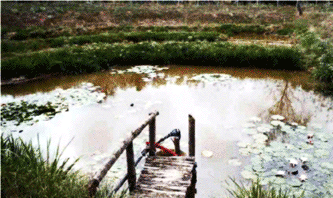Constructed wetlands, natural water purification systems
What problem does it solve?

Detail of a Surface Free-flow System for a wine-producing firm (Siena, Italy)
As mentioned above, Constructed Wetlands systems for the treatment of waste water is a widely-used choice in most countries in the European Community. University and research institutions continue to test the models and process kinetics developed for different types of waste and different environmental and climatic conditions, in relation to the choice of structures adopted. This research has made it possible to use the systems even for wastes containing high levels of contaminants for example, the percolation elements of urban solid wastes and zootechnical refluents.
Constructed Wetlands, whether used for secondary or tertiary (refinement) waste treatment, are a solid structural solution capable of high-level purification (above all for parameters including COD, BOD5, suspended and sedimentable solids, microbe loads and nitrogen) by way of a simple and uncomplicated operation with much lower environmental impact and energy consumption than other purification systems. In many cases the effluent waters move by gravity so the systems require no source of electricity. Furthermore, the Constructed Wetlands systems are not affected by variations in the hydraulic charge to be treated, unlike conventional purifiers which require a constant hydraulic charge. This means that for facilities or communities with significant fluctuations in consumption during the year (for example winemaking facilities, food-producing farms, hotels, campgrounds, cities with a tourism trade, etc.), the use of Constructed Wetlands phytopurification does not lead to reduced purification levels.
SOME ADVANTAGES OF USING CONSTRUCTED WETLANDS
• Excellent purification results
• Limited operating costs
• Simple operating mechanisms
• Low or non-existent energy consumption
• Adaptability to load variations
• Maximum oxygenation of the effluent waters
• Maximum blending with the landscape
• Possibility of re-using treated waters and treatment byproducts
• Environmental restoration of degraded sites
DOWNLOAD THE BROCHURE PDF
english (1.0 MB)spanish (0.7 MB)
albanian (0.4 MB)








 COUNTRY OF ORIGIN
COUNTRY OF ORIGIN OUTSTANDING IDEASS PROJECTS
OUTSTANDING IDEASS PROJECTS